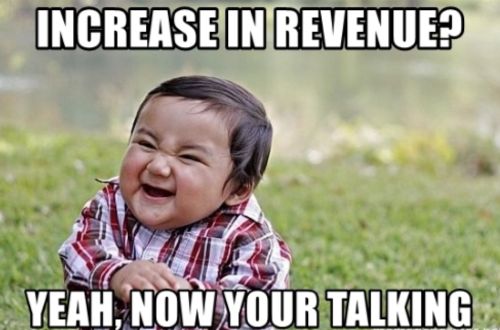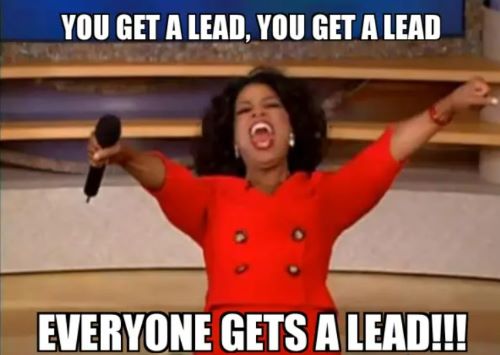Table of Contents
How Buyer Personas Directly Drive Revenue Growth is not just a marketing idea—it’s a strategic lever for the C-suite. In a landscape where every dollar must show ROI, personas help focus efforts on the buyers most likely to convert, spend more, and stay longer. When built on real data and applied organization-wide, they streamline sales, sharpen marketing, and drive measurable, profitable growth.
Unlocking Revenue Growth Through Strategic Buyer Personas

The challenge for any business owner and executive is navigating the path to sustainable, profitable growth in a dynamic market. Budgets are tight, competition is fierce, and every investment must demonstrate a clear return. You see marketing campaigns that seem to miss the mark, sales cycles that drag on, and resources spent on initiatives that don’t visibly move the needle on the P&L. Inefficient spend isn’t just a line item; it’s a barrier to reaching critical sales growth objectives and maximizing shareholder value.
Why Buyer Personas Belong in the C-Suite Conversation
Enter the concept of buyer personas. For too long, these have been relegated to the marketing department, often seen as abstract profiles or fluffy exercises. But for the C-suite focused on revenue operations and bottom-line results, this perspective is fundamentally flawed. Buyer personas, when defined and utilized correctly, are not mere marketing tactics; they are powerful, strategic revenue drivers. They provide a granular, actionable understanding of who your most profitable customers are, why they buy, and how to reach them effectively and efficiently.
Defining buyer personas from an executive standpoint means focusing on the segments that represent the highest potential for revenue, retention, and profitability. It’s about identifying the characteristics, motivations, and behaviors of the customers you want to acquire and keep. These are the individuals who contribute most significantly to your sales growth and customer lifetime value. This isn’t just demographic profiling; it’s a deep dive into psychographics, pain points, goals, and buying journeys that differentiate high-value prospects from the rest.
It’s essential to distinguish buyer personas from broader concepts such as Ideal Customer Profiles (ICPs) and market segmentation. An ICP describes the type of company you want to target (size, industry, revenue, location). Market segmentation divides the entire market into broad groups based on demographics or firmographics. Buyer personas, however, delve into the individual human beings within those ideal companies or market segments. They provide the rich, qualitative context that explains the why behind buying decisions. This actionable difference is precisely what allows sales and marketing efforts to become hyper-focused, leading directly to measurable improvements in efficiency and revenue generation.
The Persona-Revenue Link: Moving Beyond Theory to Bottom-Line Impact
The true value of buyer personas emerges when they become the strategic backbone for sales and marketing execution. They provide the necessary intelligence. This allows a shift from a scattergun approach to a precise, targeted methodology. That shift directly impacts the metrics executives care about most: revenue, cost of acquisition, and efficiency.
The Executive Challenge: Stagnant Growth, Inefficient Spend
In today’s competitive landscape, organic growth can feel elusive. Marketing budgets can feel like black holes with unclear ROI. Sales teams may struggle with inconsistent lead quality and prolonged cycles. This leads to flatlining revenue despite significant investment. It results in high Customer Acquisition Costs (CAC) and a pervasive sense of inefficiency that eats away at profit margins. Executives are constantly seeking levers to pull. They want ones that promise not just activity, but measurable results that appear favorably on the financial statements.
Introducing Buyer Personas as a Strategic Revenue Driver, Not Just a Marketing Tactic
Viewing buyer personas solely as a marketing exercise fundamentally misses their strategic potential. For the C-suite, they should be understood as a critical input into the entire revenue operations engine. Buyer personas:
- Inform sales strategy.
- Shape product development priorities.
- Influence customer service protocols.
- Guide marketing execution.
When integrated across the organization, they provide a unified, customer-centric view. This view aligns every function toward acquiring and retaining the most profitable customers. That alignment is the bedrock of efficient and predictable revenue growth.
Defining Buyer Personas for the C-Suite: Focusing on Profitable Segments
From an executive perspective, persona development begins with data and profitability analysis. It requires answering key questions:
- Which customer segments generate the highest revenue?
- Which have the longest customer lifetime value (CLTV)?
- Which are the easiest or most cost-effective to acquire?
This approach ensures that persona development focuses on the most valuable and strategic opportunities.
Personas built for the C-suite aren’t just about demographics. They are profiles of the most valuable buyers. These profiles detail their business challenges, strategic objectives, decision-making processes, and the financial impact of their problems.
This focus makes sure that the resulting personas guide investment toward the most lucrative opportunities.
Distinguishing Personas from ICPs and Market Segmentation: The Actionable Difference for Revenue
While Ideal Customer Profiles (ICP)’s and market segmentation provide valuable frameworks, buyer personas add the critical layer of human insight needed for effective engagement. An ICP tells you to target large enterprises in the healthcare sector. Segmentation might break that down by region or size. A buyer persona for that segment, however, tells you:
“Meet Sarah, the VP of Operations at a large regional hospital. She’s overwhelmed by regulatory compliance burdens (pain point). She reports directly to the CEO (decision-making influence). She values solutions that demonstrate clear ROI within 12 months (buying criteria). And she primarily consumes information through industry webinars and peer networks (preferred channels).”
This level of detail makes the persona the actionable blueprint for sales conversations, marketing messages, and product features that resonate and convert.
How Personas Directly Fuel Sales Growth and Efficiency
The direct impact of well-defined buyer personas on sales performance is profound and quantifiable. They empower sales teams to work smarter, not just harder, by focusing efforts on the right prospects with the right message at the right time. This translates directly into improved pipeline health and accelerated revenue.
Improving Lead Quality and Conversion Rates

This is one of the most immediate and measurable impacts. When marketing and sales understand the ideal buyer at a granular level, lead generation efforts can be precisely targeted to attract individuals who fit these profiles.
- Aligning Sales Efforts with High-Potential Leads: Personas provide sales with a clear filter. They know who to prioritize in their pipeline. This ensures they spend valuable time on prospects most likely to close and become profitable customers. This reduces time wasted on unsuitable leads.
- Tailoring Sales Conversations for Maximum Relevance and Impact: Sales reps armed with persona insights can personalize their outreach and conversations. They understand the prospect’s specific challenges, goals, and preferred communication style. This allows them to speak directly to the buyer’s needs and demonstrate empathy. By doing so, they build rapport and trust faster. This tailored approach is far more effective than generic pitches.
- Shortening Sales Cycles by Addressing Core Persona Needs: By understanding the buyer’s primary pain points and decision criteria from the outset, sales can proactively address concerns. They can also highlight relevant solutions. This speeds up the evaluation process, reduces objections, and accelerates the prospect’s movement through the sales funnel. As a result, the average sales cycle length is significantly shortened.
- Increasing Opportunity-to-Close Conversion Rates: When sales focus on higher-quality leads, they have more relevant conversations. They move prospects through the cycle faster. As a result, the percentage of opportunities that convert into closed deals naturally increases. This is a direct boost to sales productivity and revenue generation.
Enhancing Sales Enablement and Performance
Personas don’t just benefit individual reps. They are powerful tools for sales leadership to train, manage, and optimize the entire sales force.
- Providing Sales Teams with Deep, Actionable Customer Insights: Personas serve as readily accessible cheat sheets for the sales team. They synthesize complex market research and customer data into easy-to-understand profiles that reps can reference before every call or meeting. This allows the entire team to operate with a consistent, insightful understanding of the buyer.
- Developing Persona-Specific Sales Playbooks and Messaging Frameworks: Based on the unique challenges and buying processes of each persona, sales leadership can develop tailored playbooks, scripts, and messaging frameworks. These resources guide reps on how to best engage. They outline what questions to ask. They show how to handle objections. They explain how to position solutions specifically for each buyer type. This leads to more consistent and effective sales interactions.
- Improving Sales Forecasting Accuracy Based on Persona Understanding: Different personas may have different typical deal sizes, sales cycle lengths, or buying seasons. By tracking sales performance by persona, leadership gains clearer visibility into pipeline velocity and potential revenue. This leads to more accurate and reliable sales forecasts.
Driving Higher Average Deal Size and Customer Lifetime Value (CLTV)
Personas are also key to maximizing the value of each customer relationship, not just closing the initial deal.
- Identifying Upsell and Cross-Sell Opportunities Based on Persona Requirements and Goals: A deep understanding of a persona’s evolving needs and strategic objectives allows sales (and customer success) to be proactive. They can identify and position additional products or services that align with those goals. This isn’t just pushing more features. It’s providing solutions that genuinely add value based on known persona requirements. Over time, this leads to larger deal sizes..
- Building Stronger Relationships Leading to Increased Retention and CLTV: When sales and customer success teams consistently demonstrate that they understand a customer’s world — their pain points, goals, and industry context — it builds trust. It also strengthens the relationship. This deeper connection reduces churn and increases customer loyalty. Loyalty is a primary driver of higher customer lifetime value (CLTV). A retained customer is often more profitable than a newly acquired one.
- Understanding Persona Pain Points to Position Higher-Value Solutions: Personas often reveal the root causes of problems. They also show the significant impact those problems have on a buyer’s business. This allows sales to move beyond selling basic features. Instead, they can position higher-value, more comprehensive solutions that address these critical pain points effectively. The perceived value increases. This justifies a higher price point and increases the average deal size.
Maximizing Marketing ROI and Operational Efficiency
The impact of buyer personas on marketing isn’t just about creating better campaigns; it’s fundamentally about optimizing the entire marketing engine for efficiency and measurable return on investment (ROI). They shift marketing from broad-stroke efforts to precision targeting that minimizes wasted resources and maximizes conversion.
Precision Targeting and Reducing Wasted Spend
One of the most significant benefits of using personas is the ability to focus marketing resources precisely where they will have the greatest impact.
- Identifying the Most Profitable Channels and Campaigns for Specific Personas: Personas shed light on where your ideal buyers spend their time. They show how those buyers prefer to consume information. This intelligence allows marketing teams to allocate budget to the right channels, such as specific social media platforms, industry publications, search terms, or event types. It also helps define campaign themes most likely to reach and resonate with high-value personas. This minimizes investment in ineffective areas.
- Minimizing Investment in Low-Value or Non-Target Segments: Without clear persona definitions, marketing spend often leaks into the wrong audiences. These may be unlikely to convert or represent low-value potential. Personas provide the clarity needed to actively exclude non-target segments from expensive campaigns. This ensures every dollar is directed toward prospects with the highest potential return.
- Improving Overall Advertising Effectiveness and Efficiency: Whether it’s paid search, social media ads, or display advertising, persona-driven targeting delivers better results. It leads to higher click-through rates (CTR), lower cost-per-click (CPC), and significantly improved conversion rates. This is because the message is tailored to the specific needs and interests of the audience being reached. As a result, advertising ROI improves dramatically.
Creating High-Converting Content and Messaging
Content and messaging are only effective if they resonate with the intended audience. Personas provide the blueprint for creating marketing assets that connect deeply and drive action.
- Developing Marketing Collateral and Content that Resonates Directly with Persona Pain Points: Personas illuminate the specific problems, challenges, and frustrations your target buyers face. This allows marketing to create content (blog posts, whitepapers, webinars, case studies, website copy) that directly addresses these pain points, offers solutions, and positions your company as a credible resource. Content that speaks directly to a buyer’s needs is far more likely to engage and convert them.
- Optimizing Website and Landing Page Conversion Rates Through Persona Alignment: A website or landing page designed with specific personas in mind will feature messaging, visuals, and calls-to-action that are highly relevant to that audience. This personalization makes visitors feel understood and guides them towards the desired action (e.g., downloading a guide, requesting a demo), leading to higher conversion rates on key web assets.
- Increasing Email Marketing Engagement and Conversion: Persona-based segmentation allows for highly targeted email campaigns. Instead of sending generic newsletters, you can send emails with subject lines, content, and offers tailored to a persona’s specific interests or stage in the buyer journey, resulting in higher open rates, click-through rates, and conversions.
Strengthening Lead Generation and Nurturing Pipelines
Personas are instrumental in building a robust, efficient lead pipeline that consistently delivers qualified prospects to sales.
- Building Persona-Specific Lead Nurturing Tracks: Not all leads are ready to buy immediately. Different personas require different types of information and engagement to move them down the funnel. Personas allow marketing to create automated lead-nurturing sequences. These sequences deliver the right content and messaging to the right person at the right time. This builds trust and educates prospects until they are sales-ready.
- Improving the Conversion Rate from Marketing-Qualified Lead (MQL) to Sales-Qualified Lead (SQL): When marketing understands what constitutes a “qualified” lead from the sales perspective for each persona, they can act more strategically. They can implement scoring criteria and nurturing processes. These ensure that only leads who truly fit the persona profile and demonstrate buying intent are passed to sales. This significantly increases the MQL-to-SQL conversion rate. It provides sales with higher-quality opportunities.
- Increasing Lead Velocity and Pipeline Acceleration: By attracting higher-quality leads, tailoring messaging, and implementing effective persona-based nurturing, the overall speed at which leads move through the pipeline increases. This “lead velocity” is a critical indicator of pipeline health and directly contributes to accelerating revenue generation.

Quantifying the Financial Impact: Measuring Persona Success
For the C-suite, proving the value of any initiative requires tangible, measurable results. The impact of buyer personas on revenue and efficiency can and should be quantified. This requires identifying the right metrics, establishing baselines, and implementing tracking mechanisms.
Key Metrics to Track and Analyze
Measuring the success of persona implementation involves monitoring key performance indicators (KPIs) that reflect changes in sales efficiency, marketing effectiveness, and overall revenue performance.
- Lead Conversion Rates (by stage: MQL, SQL, Opportunity, Closed Won): Track conversion rates at each stage of the funnel, segmented by incoming source or campaign where possible. Look for improvements in the percentage of leads moving from one stage to the next after persona implementation, particularly the MQL-to-SQL and Opportunity-to-Closed Won rates.
- Average Deal Size (Pre- vs. Post-Persona Implementation): Compare the average value of closed deals before and after personas were fully adopted by sales. Increases often indicate success in positioning higher-value solutions or identifying cross-sell/upsell opportunities earlier.
- Sales Cycle Length (Reduction): Measure the average time it takes for a lead to move from initial contact (or MQL status) to a closed deal. A reduction indicates increased sales efficiency and better alignment with the buyer’s journey.
- Customer Acquisition Cost (CAC) (Reduction): By improving targeting and conversion rates, marketing can acquire customers more efficiently. Calculate the total sales and marketing spend divided by the number of new customers acquired, looking for a decrease over time as persona strategies mature.
- Customer Lifetime Value (CLTV) (Increase): Track the average revenue generated by a customer over their entire relationship with your company. Personas contribute to CLTV by improving retention rates and identifying opportunities for repeat business or expansion.
- Marketing Campaign ROI (Attributed to Persona Targeting): Measure the revenue generated by specific marketing campaigns targeting defined personas, relative to the cost of those campaigns. Look for higher ROI compared to campaigns that used less segmented or non-persona targeting.
- Revenue Generated Per Persona Segment: If possible, segment your closed-won revenue data by the persona type that the customer represents. This allows you to see which personas are most profitable and the direct revenue contribution of focusing on those segments.
Attributing Revenue Growth to Persona Initiatives
Direct attribution can be complex, but a structured approach allows for demonstrating the clear influence of personas.
- Establishing Baseline Performance Metrics Before Implementation: Before you fully roll out persona-based strategies, capture 6-12 months of historical data for the key metrics listed above. This provides the necessary baseline to measure against.
- Implementing Tracking Mechanisms to Monitor Persona Influence: Ensure your CRM and marketing automation platforms are set up to tag leads and opportunities with the relevant persona. This allows for segmented reporting and analysis of performance data based on persona type.
- Analyzing Performance Data Segmented by Persona: Regularly review the key metrics, breaking down the results by persona. Look for trends where performance metrics (like conversion rates or deal size) are significantly better for leads and opportunities associated with the defined target personas compared to generic or non-persona leads.
Calculating the Return on Investment (ROI) of Persona Development
Ultimately, the C-suite wants to see the ROI on the investment made in developing and implementing personas.
- Itemizing the Costs Associated with Persona Research, Creation, and Implementation: Account for all expenses, including research time, data analysis tools, workshop costs, training time for sales and marketing teams, and potentially the cost of external expertise or a structured persona development service.
- Measuring the Tangible Revenue Uplift Directly Linked to Persona Use: Using the segmented performance data (improved conversion rates, increased deal size, reduced sales cycle leading to more deals closed in the same period), quantify the additional revenue generated from persona-aligned activities compared to the baseline. Also, quantify cost savings from reduced wasted marketing spend (lower CAC).
- Presenting a Clear Business Case for Future Persona Investment: By demonstrating the positive ROI achieved, you build a compelling case for continued investment in refining personas. This supports expanding their use across the organization. It also justifies investing in tools or services that provide deeper persona insights and operationalization. Often, a structured approach to persona development, perhaps through a specialized service, can accelerate this process and bring experienced methodology, leading to a faster and more measurable revenue impact.

Implementing Personas for Tangible, Executive-Level Results
Implementing buyer personas effectively across an organization requires a strategic, cross-functional effort, not just a marketing project. It’s an investment in understanding your customer at a fundamental level, which pays dividends across every revenue-generating function.
Research and Development: Strategic Investment
Building robust, accurate personas is the critical first step. This is an investment in intelligence that will drive future decisions.
- Leveraging Internal Data (CRM, Sales Feedback, Service Records): Your existing data holds invaluable clues. Analyze CRM data for trends in customer demographics, behavior, and purchase history. Gather feedback directly from sales and customer service teams who interact with customers daily. Review support tickets and service records to understand common pain points and questions.
- Gathering External Insights (Market Research, Competitive Analysis): Supplement internal data with external perspectives. Conduct market research to understand industry trends and the competitive landscape. Analyze competitor messaging and positioning to understand how they are targeting similar segments.
- Conducting In-Depth Customer and Prospect Interviews: This is perhaps the most critical step. Go directly to the source. Conduct structured interviews with a representative sample of your best existing customers and relevant prospects. Ask open-ended questions about their challenges, goals, daily routines, influences, and buying experiences. This qualitative data brings the persona to life.
- Involving Key Stakeholders (Sales, Marketing, Product, Service): Persona development should not happen in a vacuum. Include representatives from sales, marketing, product development, and customer service in the research and creation process. Their diverse perspectives are essential for building well-rounded, accurate, and actionable personas that the entire organization will use.
- Determining the Optimal Number and Granularity of Personas: Avoid creating too many personas, which can dilute focus. Aim for a manageable number (typically 3-7) that represent your most valuable segments. The granularity should be sufficient to provide actionable insights for sales and marketing without being overly complex or niche.
Embedding Personas Across the Organization
Personas only generate revenue impact if they are actively used and integrated into daily workflows.
- Training Sales, Marketing, and Customer Success Teams: Comprehensive training is essential. Educate teams on who the personas are, their key characteristics, and how to use the persona insights in their daily tasks – whether it’s personalizing an email, tailoring a sales pitch, creating content, or resolving a customer issue.
- Integrating Personas into Core Business Processes (Sales Operations, Revenue Operations): Ensure personas are integrated into your CRM, marketing automation, and other revenue operations tools. Tagging leads and customers by persona enables segmentation for reporting, targeted campaigns, and sales routing. This operational integration ensures personas are living tools, not static documents.
- Using Personas to Inform Product Development Roadmaps: The insights gathered during persona research are invaluable for the product team. Understanding the unmet needs and desired outcomes of your key personas can directly inform the development of new features, products, or services that will be highly valued by your most profitable customer segments.
- Ensuring Buy-in and Active Sponsorship from the C-suite: For personas to be truly embedded, they need executive sponsorship. When leadership consistently references personas in strategic discussions and reinforces their importance, it signals to the entire organization that this is a priority and encourages widespread adoption and utilization.
Maintaining and Evolving Persona Strategies
The market changes, customers evolve, and your business grows. Personas must be living documents, not static artifacts.
- Recognizing Personas as Dynamic, Living Tools: Understand that personas are not a one-time project. They represent current understanding and need to be revisited and updated.
- Establishing Processes for Regular Review and Updating: Implement a schedule (e.g., annually or bi-annually) to formally review and update your buyer personas based on new data, market shifts, and feedback from the teams using them daily.
- Using Performance Data to Refine Persona Definitions and Strategies: The metrics you track (conversion rates, deal size, CLTV by persona) provide invaluable feedback. If a persona segment isn’t performing as expected, it might indicate that the persona definition needs refinement or that the strategies targeting that persona need adjustment. This data-driven refinement ensures your persona strategy remains aligned with revenue goals.
Real-World Evidence: Case Studies of Persona-Driven Growth
While specific company names often remain confidential, the patterns of success observed when organizations effectively implement buyer personas are consistent and compelling. They provide concrete illustrations of how understanding the buyer translates into tangible business results.
Anonymized Company Case Studies Showcasing Results
Consider the impact seen across various industries:

- Case Study 1: Significant Improvement in Sales Close Rates and Cycle Time. In one hypothetical example, a B2B software company struggling with inconsistent sales performance implemented detailed buyer personas after extensive customer interviews. Sales teams were trained on using the persona profiles to tailor their calls. Within two quarters, the close rate on sales-qualified opportunities increased by 18%, and the average sales cycle length decreased by 15%, directly leading to increased sales growth without adding headcount.
- Case Study 2: Demonstrable Reduction in Marketing Spend and Increase in Qualified Leads. A hypothetical e-commerce platform focused its digital advertising spend strictly on channels and messaging aligned with its two most profitable customer personas. They paused campaigns targeting broad demographics. The result was a 25% reduction in overall advertising spend while simultaneously increasing the volume of high-quality leads (defined by persona fit) by 30%, significantly lowering their customer acquisition cost (CAC).
- Case Study 3: Growth in Average Deal Size and Customer Lifetime Value. A hypothetical professional services firm used personas not just for initial sales, but for ongoing client management. By understanding clients’ long-term strategic goals (identified in persona research), account managers proactively identified opportunities for additional services. Over 18 months, the average annual revenue per client increased by 20%, contributing directly to higher average deal size and a notable increase in customer lifetime value (CLTV).
Supporting Data and Industry Statistics
While precise, universally applicable statistics are hard to come by, industry data tells a clear story. Variations in industries and implementation quality make exact figures difficult. However, there is a strong correlation between well-defined buyer personas and improved revenue performance metrics.
Reports often show that companies with documented personas achieve higher lead conversion rates. They also see improved marketing ROI and better sales productivity compared to those without. The aggregate results across multiple implementations highlight one key takeaway: deep customer understanding is a strategic necessity.
Expert Perspectives on Persona’s Strategic Value
Experts in revenue operations, sales enablement, and strategic marketing consistently highlight the critical role of buyer personas in achieving alignment and driving growth. They emphasize that a shared, deep understanding of the customer across sales, marketing, and service teams is foundational to efficient operations and sustainable revenue increases. Persona development is increasingly viewed not just as a marketing task, but as a strategic business initiative vital for competitive advantage.
Aligning Sales and Marketing with Personas That Deliver Results
Understanding your buyer isn’t just good practice; it’s a fundamental requirement for predictable, profitable growth. Buyer personas, built on solid data and deep insights, are the tools that translate this understanding into action across your sales, marketing, and service organizations.
The link between buyer personas and revenue is clear and measurable. They improve lead quality, increase conversion rates, shorten sales cycles, boost deal size and CLTV, and optimize marketing spend. They also enhance the efficiency of your entire revenue engine.
By focusing your resources on the customers who matter most—guided by the actionable insights personas provide—you can drive significant sales growth. You can also achieve marketing efficiency that directly impacts your bottom line.
This isn’t abstract marketing theory. It’s a strategic framework for delivering tangible, executive-level results. It justifies every dollar invested in understanding your customer.
For executives looking to move the needle on revenue, a structured approach to persona development is essential. Embedding these insights across the organization is not just a recommendation. It’s a strategic imperative for navigating complexity and achieving sustainable growth in today’s market.


